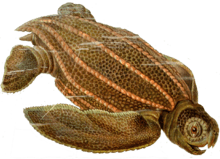Cheloniology

Cheloniology (/kəloʊniːɒlədʒi/), less commonly known as testudinology (/tɛstuːdɪnɒlədʒi/), is the scientific study of turtles. It is a specific branch of herpetology. The word cheloniology comes from the Greek chelone, "turtle" and logos, "knowledge". Testudinology, on the other hand, comes from the Latin testudo, "tortoise" and the Greek logos, meaning "knowledge". An individual who studies turtles is known as a cheloniologist or a testudinologist.
Fields of study
Cheloniologists study turtles, which are members of the order Testudines (also called Chelonii). This includes freshwater turtles, sea turtles, tortoises, and terrapins. Professionally, members of this order are commonly called chelonians, as opposed to any of the other names previously mentioned. This cuts down on much confusion, as the distinctions between turtles, tortoises, and terrapins are more linguistic than they are biological. All are very closely related.
Within cheloniology, scientists study a wide range of topics including chelonian anatomy, behavior, ecology, evolution, disease, conservation, and many others. Cheloniologists may specialize in one or more of these fields, rather than in general cheloniology.
Background
Cheloniology is rooted in biology and zoology, specifically in herpetology. As degrees in cheloniology itself are unheard of in universities and colleges, cheloniologists commonly have degrees in the above fields, as well as biochemistry, paleozoology, marine biology, and others.
Discoveries
Cheloniologists have somewhat recently discovered that chelonians' organs display negligible senescence. This discovery has prompted researchers to do more investigation into the chelonian genome and its impacts on longevity.
Phylogeny of extant chelonians
The following phylogeny of extant chelonians is based on the work of Crawford et al. (2015)[1] and Guillon et al. (2012).[2]
|
| ||||||||||||||||||||||||||||||||||||||||||||||||||||||||||||||||||||||||||||||||||||||||||||||||||||||||||||||||||||||||||||||||||||||||||||||||||||||||||||||||||||||||||||||||||||||||||||||||||||||||||||||||||||||||||||||||||||||||||||||||||||||||||||||||||||||||||||||||||||||||||||||||||||||||||||||||||||||||||||||||||||||||||||||||||||||||||||||||||||||||||||||||||||||||||||||||||||||||||||||||||||||||||||||||||||||||||||||||||||||||||||||||||||||||||||||||||||||||||||||||||||||||||||||||||||||||||||||||||||||||||||||

Conservation of chelonians
At somewhere between 48 and 54% of all 330 or so chelonian species being threatened, they are at a much higher risk of extinction than many other vertebrates. Of the around 250 species of freshwater and terrestrial turtles, 117 species are considered Threatened, 73 are either Endangered or Critically Endangered and 1 is Extinct. All 7 species of sea turtles are endangered, with some considered critically endangered. Of the 58 species belonging to the Testudinidae family, 33 species are Threatened, 18 are either Endangered or Critically Endangered, 1 is Extinct in the wild and 7 species are Extinct. 71% of all tortoise species are either gone or almost gone. Asian species are the most endangered with around 75% being considered threatened,[3] closely followed by the five endemic species from Madagascar.
Research organizations
Cheloniology research organizations exist all over the world, spanning many countries. This list comprises just a few of the notable ones.
- Archie Carr Center for Sea Turtle Research, University of Florida
- Chelonian Research Institute, founded by Peter Pritchard, in Oviedo, Florida
- Dewees Island Turtle Team
- East Coast Biologists, Inc.
- Ecological Associates, Inc.
- Hawaii Preparatory Academy Sea Turtle Research Program
- Innovation Academy for Engineering, Environmental & Marine Science
- Inwater Research Group
- Oceana
- Padre Island National Seashore, Division of Sea Turtle Science and Recovery
- Marine Turtle Research Group of China, a.k.a. the National Huidong Sea Turtle Reserve (Chinese: 广东惠东海龟国家级自然保护区管理局)
- Israel Nature and Parks Authority - Sea Turtle Rescue Center (Hebrew: המרכז הארצי להצלת צבי ים)
- Red Sea Turtle Project
- Chelonian Research Group (not to be confused with the Chelonian Research Institute of the U.S.)
- Marine Turtle Research Group
See also
References
- ↑ Crawford, Nicholas G.; et al. (2015). "A phylogenomic analysis of turtles". Molecular Phylogenetics and Evolution. 83: 250–257. doi:10.1016/j.ympev.2014.10.021. PMID 25450099.
- ↑ Guillon, Jean-Michel; et al. (2012). "A large phylogeny of turtles (Testudines) using molecular data". Contributions to Zoology. 81 (3): 147–158.
- ↑ Hylton, H. (May 8, 2007). "Keeping U.S. Turtles Out of China". Time. Retrieved 1 November 2012.
_white_background.jpg)
_flipped.jpg)




_white_background.jpg)

_white_background.jpg)
_white_background.jpg)
_white_background.jpg)




_flipped.jpg)
_white_background.jpg)